 There are some landscape materials I cannot get enough of. Decomposed granite is a material comprised of pieces of granite 3/8ths of an inch across, and smaller. The smaller pieces are known as “fines”. The fines sift down in between the 3/8 inch pieces, and interlock the decomposed granite. This makes for a surface that delivers that beautiful sound with every step that says garden, dead ahead. Decomposed granite looks like sand when it is delivered. I have taken plenty of panic stricken phone calls from clients. But once it is laid down, graded, compacted and washed, it is a surface that won’t give no matter how high those heels are. I have no love for asphalt as a surface; does it not seem like a symbol of all those places we have paved over without cause? Concrete is a great material, as long as it is used with architecture that asks for it. Concrete aggregate is beautiful for modern or contemporary landscapes-I hate to see it used by a client who really wanted gravel, but was too afraid. My mentor and dear friend Al Goldner, told me once his only regret as a designer was that he was not bold enough; be bold!
There are some landscape materials I cannot get enough of. Decomposed granite is a material comprised of pieces of granite 3/8ths of an inch across, and smaller. The smaller pieces are known as “fines”. The fines sift down in between the 3/8 inch pieces, and interlock the decomposed granite. This makes for a surface that delivers that beautiful sound with every step that says garden, dead ahead. Decomposed granite looks like sand when it is delivered. I have taken plenty of panic stricken phone calls from clients. But once it is laid down, graded, compacted and washed, it is a surface that won’t give no matter how high those heels are. I have no love for asphalt as a surface; does it not seem like a symbol of all those places we have paved over without cause? Concrete is a great material, as long as it is used with architecture that asks for it. Concrete aggregate is beautiful for modern or contemporary landscapes-I hate to see it used by a client who really wanted gravel, but was too afraid. My mentor and dear friend Al Goldner, told me once his only regret as a designer was that he was not bold enough; be bold!
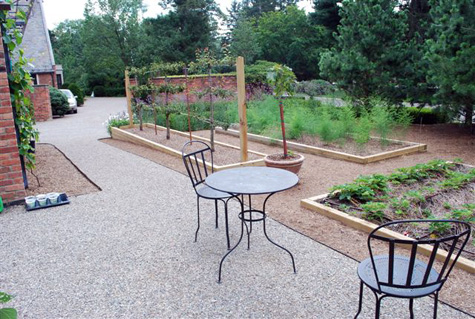 Decomposed granite, properly installed, makes for a driveway impervious to tire marks. In this landscape, the driveway flowed seamlessly into paths for a vegetable and cutting garden.
Decomposed granite, properly installed, makes for a driveway impervious to tire marks. In this landscape, the driveway flowed seamlessly into paths for a vegetable and cutting garden.
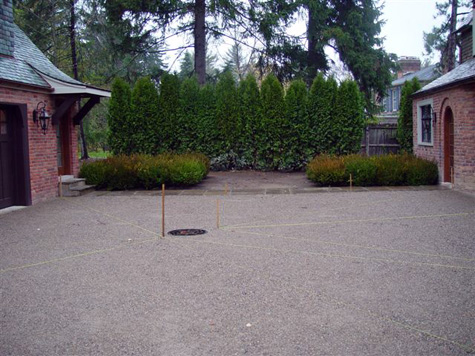 A driveway of decomposed granite requires an expert installation. GP Enterprises does these drives for me. They are so careful to install with a careful eye to grade and drainage. They compact the granite with the same machinery that compacts asphalt.
A driveway of decomposed granite requires an expert installation. GP Enterprises does these drives for me. They are so careful to install with a careful eye to grade and drainage. They compact the granite with the same machinery that compacts asphalt.
 Decomposed granite makes a great mulch for comtemporary landscapes. This landscape did not ask for mulch-that granite completed a thought.
Decomposed granite makes a great mulch for comtemporary landscapes. This landscape did not ask for mulch-that granite completed a thought.
 Decomposed granite can finish a formal planting, as well as a contemporary one. It is clean, fresh, and crisp. It is easy to make shapes, and moves; it does a great job of giving the eye a place to rest.
Decomposed granite can finish a formal planting, as well as a contemporary one. It is clean, fresh, and crisp. It is easy to make shapes, and moves; it does a great job of giving the eye a place to rest.
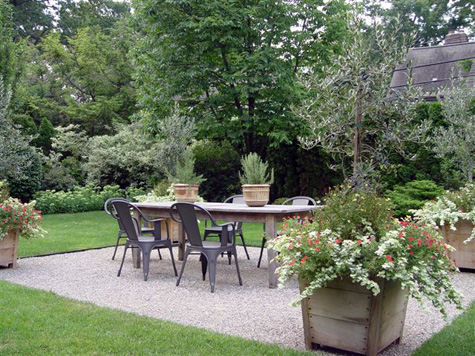 I have done many a terrace in decomposed granite. It is a clean surface, not so demanding of attention as stone. This garden makes much of the pots and the furniture-the granite is a quietly beautiful surface. It is the color of nature, a texture that celebrates all that is set on it.
I have done many a terrace in decomposed granite. It is a clean surface, not so demanding of attention as stone. This garden makes much of the pots and the furniture-the granite is a quietly beautiful surface. It is the color of nature, a texture that celebrates all that is set on it.
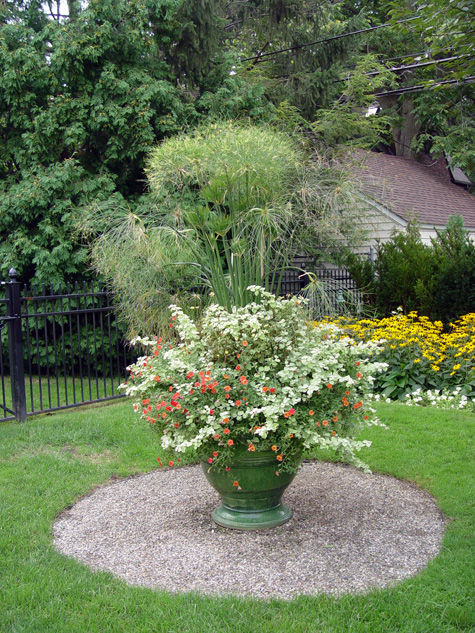 This material is useful for more than driveways and paths. Some plantings need a special space of their own.
This material is useful for more than driveways and paths. Some plantings need a special space of their own.
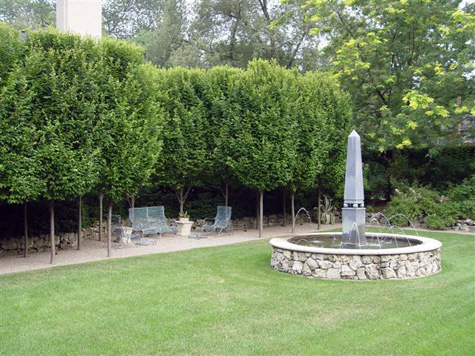 Wherever people may be in a landscape, I wonder if this surface will play a part. The granite did a great job of featuring the stone from the 1920’s original to this garden.
Wherever people may be in a landscape, I wonder if this surface will play a part. The granite did a great job of featuring the stone from the 1920’s original to this garden.
Some materials are so versatile, which makes decomposed granite a major player in my palette of hard surfaces. Great for driveways, friendly to plants-amazing how it can work in contemporary landscapes as well as vintage ones.
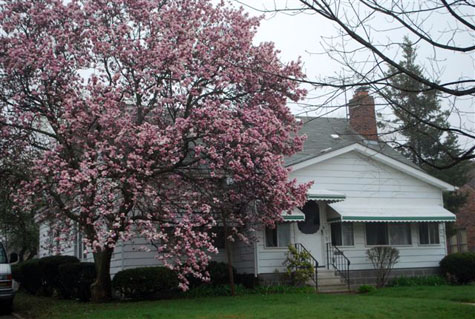 Everyone makes decisions about a life’s work. Whether they think it through, or not, decisions get made. As a landscape designer, I realized part of my life’s work was to plant magnolias-all manner of magnolias, every where it made good design sense to plant them. I am a designer who in part came to design via a love for plants. Plants are part of the vocabulary that helps give voice to a point of view. Every designer needs heart, soul, and nerve-but they also need language.
Everyone makes decisions about a life’s work. Whether they think it through, or not, decisions get made. As a landscape designer, I realized part of my life’s work was to plant magnolias-all manner of magnolias, every where it made good design sense to plant them. I am a designer who in part came to design via a love for plants. Plants are part of the vocabulary that helps give voice to a point of view. Every designer needs heart, soul, and nerve-but they also need language.
 Phil Savage, lived on almost 8 acres-most of which reflects a lifetime growing and hybridizing magnolias. He also grafted magnolia cuttings onto ash tree root stock-these trees are 70 feet tall on his property, as we speak. He hybridized “Yellow Butterflies”; when the spring weather is perfect, it is a dream come true in bloom. Later, it is sturdily and robustly green. His property had magnolias of a size, with flowers in colors, I have never seen-yellow, peach, orangy pink. It was like a visit to another planet. But no, just a visit to a man who knew and lived his life’s work.
Phil Savage, lived on almost 8 acres-most of which reflects a lifetime growing and hybridizing magnolias. He also grafted magnolia cuttings onto ash tree root stock-these trees are 70 feet tall on his property, as we speak. He hybridized “Yellow Butterflies”; when the spring weather is perfect, it is a dream come true in bloom. Later, it is sturdily and robustly green. His property had magnolias of a size, with flowers in colors, I have never seen-yellow, peach, orangy pink. It was like a visit to another planet. But no, just a visit to a man who knew and lived his life’s work.
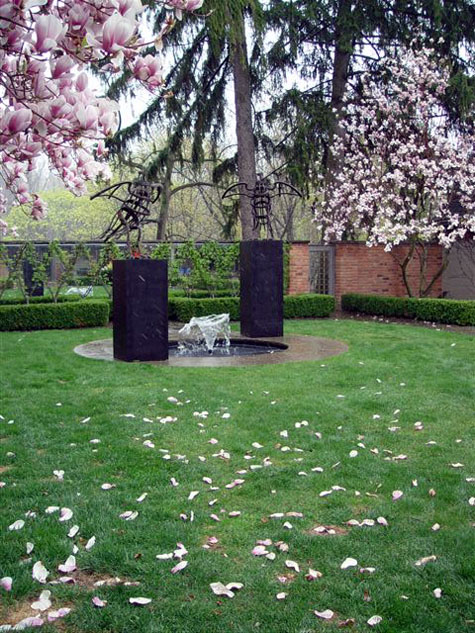

 I did the project pictured many years ago in central Indiana. My client built this house in the middle of 80 acres of farmland. He and his wife tithed the use of this land, to grow corn, to their church. The landscape became a farm, and the farm was a landscape. All of the woody material was planted in rows, as if they were crops. I designed a pattern of the planting of the corn perpendicular to the woody planting of the landscape, so as to connect this very large house to a large piece of ground. This many years before I ever learned about crop circles.
I did the project pictured many years ago in central Indiana. My client built this house in the middle of 80 acres of farmland. He and his wife tithed the use of this land, to grow corn, to their church. The landscape became a farm, and the farm was a landscape. All of the woody material was planted in rows, as if they were crops. I designed a pattern of the planting of the corn perpendicular to the woody planting of the landscape, so as to connect this very large house to a large piece of ground. This many years before I ever learned about crop circles.  I was especially happy with this landscape, as I was able to persuade my client to commit to a big idea, and use smaller material, so as to keep within their budget. Big houses need big ideas as much as small houses do. I have never been back to see the project, but I hope that it is all still there, sturdy and strong.
I was especially happy with this landscape, as I was able to persuade my client to commit to a big idea, and use smaller material, so as to keep within their budget. Big houses need big ideas as much as small houses do. I have never been back to see the project, but I hope that it is all still there, sturdy and strong.
 OK, I have spent days detailing my childhood exposure and love of dirt-how does this pertain to you? Sculpting ground-this is a fancy definition for “grading”. Grading dirt, simply stated, it is the process of moving dirt around, so water drains, there are flat places to be, and the sculpture of the ground which will become your landscape, looks interesting, and beautiful. We can lower the dirt here; we can raise the dirt here. We can feather that area into this one. How the house sits on the land is a big issue for new homes-thus many cities require grading plans. The project pictured tried to address a specific landscape issue. A giant bumpy lawn on a considerable slope was not hospitable to either my client, or her guests. The space needed some flat ground, and a sense of some intimacy. The lawn was greatly over scaled for people. Nor was the shape of the lawn beautiful. With an earthmover, and rakes, the ground became sculptural and beautiful-but also useable. I call this a grass amphitheater.
OK, I have spent days detailing my childhood exposure and love of dirt-how does this pertain to you? Sculpting ground-this is a fancy definition for “grading”. Grading dirt, simply stated, it is the process of moving dirt around, so water drains, there are flat places to be, and the sculpture of the ground which will become your landscape, looks interesting, and beautiful. We can lower the dirt here; we can raise the dirt here. We can feather that area into this one. How the house sits on the land is a big issue for new homes-thus many cities require grading plans. The project pictured tried to address a specific landscape issue. A giant bumpy lawn on a considerable slope was not hospitable to either my client, or her guests. The space needed some flat ground, and a sense of some intimacy. The lawn was greatly over scaled for people. Nor was the shape of the lawn beautiful. With an earthmover, and rakes, the ground became sculptural and beautiful-but also useable. I call this a grass amphitheater.
 As I have said before, I have loved moving dirt my whole life. How this helps you is as follows. You have a life you are dealt, and a life you make. Look at what you were dealt, and imagine it better; imagine it beautiful, then move some dirt around.
As I have said before, I have loved moving dirt my whole life. How this helps you is as follows. You have a life you are dealt, and a life you make. Look at what you were dealt, and imagine it better; imagine it beautiful, then move some dirt around.
